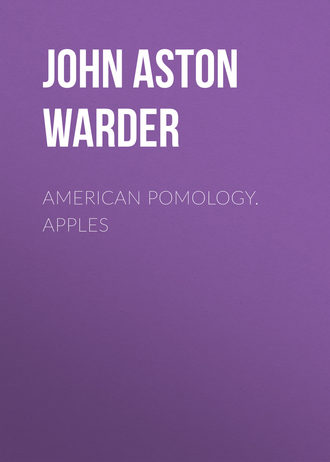 полная версия
полная версияПолная версия
American Pomology. Apples
The next character, and one of considerable value, is that dependent upon flavor in its broadest characters of sweet and sour, which, though sometimes giving rise to a puzzling question, is, in most varieties, sufficiently marked to constitute the basis of a minor sub-division. Color, which is notoriously the poorest character and least esteemed by botanists in their descriptions, on account of its liability to variation, is, however, of sufficient importance in pomology to take a high rank and to appear very prominently in fruit nomenclature. Still it should be reserved for the lowest sub-divisions of a classification.
Among our American writers, who deservedly stand prominent as pomologists, the most satisfactory attempt at classification is found in the little work prepared by J.J. Thomas. No one who has realized the advantages to be derived from the simple and clear sub-divisions made by this author, will ever be satisfied with a fruit-book that is not arranged upon the basis of some classification. Thomas, in his excellent work, makes three great divisions of apples according to their period of ripening, as the Summer, Autumn, and Winter fruits, to which some of us would desire to add Spring, or long-keepers. Each of these he has divided into two classes—those characterized by their flavor as sweet apples, and those possessed of more or less acidity; and each of these classes is subdivided into two sections, according to their color, as striped with red and not striped; so that in this arrangement we have eighteen groups, and, with specimen in hand, this synopsis enables us at once to decide in which of these groups of moderate dimensions we may look for the description we desire; and, if it be contained in the book, it may readily be found. The labor of searching through the whole list is thus obviated.
The Germans have made many attempts at the classification of fruits. Christ, Diel, Dochnahl, Manger and Sickler, have been engaged in this work; and Diel's Synopsis, though far from perfect, has been generally adopted. He makes seven classes, with orders under each. Dochnahl, a later writer, has modified this by making two sections according to the shape, whether angular or spherical, and four classes also based upon their form.
Robert Hogg, in his British Pomology, which is an excellent account of the apples cultivated in England, has given a modification which answers a good purpose for classification. He makes three great sections, according to season, Summer, Autumn, and Winter. Each of these is divided into two classes, according to shape: 1st, Round, roundish, or oblate; and 2nd, Oblong, conical, oval, or ovate. These again are grouped according to their colors: A, pale; B, striped; C, red; and D, russet.
As a matter of interest I will give Diel's classification.
CLASS I.—RIBBED APPLES1. They are furnished with very prominent, but regular ribs around the eye, extending also over the fruit, but which do not render it irregular.
2. Having wide, open, and very irregular cells.
ORDER I.—TRUE CALVILLES1. They taper from about the middle of the fruit toward the eye.
2. They are covered with bloom when on the tree.
3. They have, or acquire, by keeping, an unctuous skin.
4. They are not distinctly and purely striped.
5. They have light, spongy, delicate flesh.
6. They have a strawberry or raspberry flavor.
ORDER II.—SCHLOTTER ÆPFEL1. The skin does not feel unctuous.
2. They are not covered with bloom.
3. They are either of a flat, conical, cylindrical, or tapering form.
4. They have not a balsamic, but mostly a sweetish or sourish flavor.
5. They have a granulous, loose, and coarse-grained flesh.
ORDER III.—GUELDERLINGE1. They are not balsamic, like Order I., but of an aromatic flavor.
2. They have a fine flesh, almost like that of the Reinettes.
3. They are either of a conical or flat shape.
4. They are most prominently ribbed around the eye.
CLASS II—ROSENÆPFEL—ROSE APPLES1. They are covered with blue bloom when on the tree.
2. They have not unproportionally large, but often only regular cells.
3. They emit a pleasant odor when briskly rubbed.
4. The skin does not feel unctuous.
5. They are handsomely and regularly ribbed around the eye, and often also over the fruit.
6. They have a tender, loose, spongy, and mostly fine grained flesh.
7. They have a fine rose, fennel, or anise flavor.
8. They are mostly of short duration, and are often only summer or autumn apples.
9. They are mostly striped like a turnip.
ORDER I.—FRUIT TAPERING OR OBLONGORDER II.—FRUIT ROUND OR FLATCLASS III.—RAMBOURS1. They are all large apples, and comprise the largest sorts.
2. They have mostly, or almost always, two unequal halves—namely, one side lower than the other.
3. They are constantly furnished with ribs around the eye which are broad, rising irregularly, one above the other, and extending over the fruit so as to render it irregular in its shape; they are also compressed, and have one side higher than the other.
4. They are constantly broader than high, and only sometimes elongated.
5. They have all a loose, coarse grained and often very pleasant flesh.
ORDER I.—WITH WIDE CELLSORDER II.—WITH NARROW CELLSCLASS IV.—REINETTES1. They have a fine grained, delicate, crisp, firm flesh.
2. They are mostly the ideal of a handsomely shaped apple; in them the convexity or bulge of the middle of the apple towards the eye is the same as that towards the stalk, or not much different.
3. They are all gray dotted, or have russety patches, or completely covered with russet.
4. They have rarely an unctuous skin.
5. They have all the rich, aromatic, sugary, and brisk flavor, which is called the Reinette flavor.
6. They decay very readily, and must, of all apples, hang longest on the tree.
7. The really sweet and at the same time aromatic apples belong to the Reinettes, only as regards their shape, their character, and their fine and firm flesh.
8. Apples with fine, firm, crisp flesh, which cannot of themselves form a distinct class; for instance, the Pippins belong to this class.
ORDER I.—SELF-COLORED REINETTES1. Having a uniform green ground color, which changes to the most beautiful golden yellow.
2. Having no lively colors or marks of russet on the side next the sun, except those that are very much exposed, and which assume a slight tinge of red.
3. Having no covering of russet, but only slight traces of russety stripes.
ORDER II.—RED REINETTESHaving all the properties of the self-colored Reinettes, but of a pure red on the side next the sun, without any mixture of russet.
ORDER III.—GRAY REINETTES1. The ground color is green, changing to dingy dull yellow.
2. The coating of russet, or the russety patches, spread over the greater part of the fruit, are very conspicuous.
3. The side next the sun is often dull brownish or ochreous red.
ORDER IV.—GOLDEN REINETTES1. On the side next the sun they are washed or striped with beautiful crimson.
2. The ground color changes by keeping to a beautiful deep yellow.
3. Over the ground color, and the crimson of the exposed side, are spread light thin patches, or a complete coat of russet.
CLASS V.—STREIFLINGE—STRIPED APPLES1. They are all, and almost always, marked with broken stripes of red.
2. These stripes are found either over the whole fruit, or only very indistinctly on the side exposed to the sun.
3. The stripes may be distinct—that is to say, truly striped; or between these stripes on the side next the sun the fruit is dotted, shaded, or washed with red; but on the shaded side the stripes are well defined.
4. The cells are regular.
5. They are of a purely sweet, vinous, or acid flavor.
6. They have not the same flavor as the Rose apples.
7. They do not decay, except when gathered before maturity.
ORDER I.—FLAT STREIFLINGE1. They have the bulge at the same distance from the eye as from the stalk, and are broadly flattened.
2. They are constantly half an inch broader than high.
ORDER II.—TAPERING STREIFLINGE1. They are broader than high.
2. They diminish from the middle of the apple towards the eye, so that the superior half is conical or pyramidal, and not at all similar to the inferior half.
ORDER III.—OBLONG OR CYLINDRICAL STREIFLINGE1. The hight and breadth are almost equal.
2. They diminish gradually from the base to the apex.
3. Or from the middle of the fruit they gradually diminish toward the base and apex equally.
ORDER IV.—ROUND STREIFLINGE1. The convexity of the fruit next the base and the apex is the same.
2. The breadth does not differ from the hight, except only about a quarter of an inch.
3. Laid in the hand, with the eye and stalk sidewise, they have the appearance of a roundish grape.
CLASS VI.—TAPERING APPLES1. They have the cells regular.
2. They are not covered with bloom.
3. They are not striped, and are either of a uniform color, or washed with red on the side next the sun.
4. Constantly diminishing to a point towards the eye.
5. They are sweet or vinous, approaching a pure acid.
6. They do not readily decay.
ORDER I.—OBLONG, CYLINDRICAL OR CONICALCharacters the same as Order III. of the Streiflinge.
ORDER II.—TAPERING TO A POINTCharacters the same as Order II. of the Streiflinge.
CLASS VII.—FLAT APPLES1. They are constantly broader than high.
2. They are never striped.
3. They are either of a uniform color, or, on the side exposed to the sun, more or less washed or shaded with red.
4. They have regular cells.
5. They are not unctuous when handled.
6. They do not readily decay.
7. Flavor purely sweet, or purely sour.
ORDER I.—PURELY FLAT APPLES1. The difference is obvious to the eye.
2. The breadth is constantly half an inch more than the hight.
ORDER II.—ROUND-SHAPED FLAT APPLES1. The eye cannot easily detect a distinction between the breadth and hight.
2. The breadth rarely exceeds the hight by a quarter of an inch.
3. The fruit, cut transversely, exhibits almost or quite two equal halves.
DOCHNAHL'S CLASSIFICATION
SECTION I.—PLEUROIDEA.—Angular or RibbedHaving sharp or flat ribs, which extend over the length of the fruit and are most prominent around the eye, where they are most generally situated.
CLASS I.—MALA CYDONARIA—Quince-shapedORDER I.—CALVILLES1. They have large heart-shaped cells, open towards the axis, or often entirely torn; the cells extend very often from the stalk even to the tube of the calyx.
2. They diminish from about the middle of the fruit, or a little above it, towards the eye.
3. They are regular, and provided generally with fine ribs, which do not disfigure the fruit.
4. On the tree, the fruit is covered with bloom.
5. They are never distinctly striped.
6. Their flesh is soft, loose, fine and light, of a balsamic flavor, similar to that of strawberries or raspberries.
7. The eye is frequently closed.
8. Many of them acquire by keeping an oily or unctuous skin.
Group I.—Fruit red, almost entirely covered with red.
Group II.—Fruit parti-colored; yellow; very much striped or washed with red.
Group III.—Fruit yellow; of a whitish, greenish, or golden yellow.
ORDER II.—PSEUDO-CALVILLES1. The cells are almost the same as the true Calvilles—very large and open.
2. The calycinal tube is wide and generally very short.
3. They are slightly narrowed toward the eye, and flattened toward the stalk.
4. Their ribs are very prominent, especially around the eye.
5. They are aromatic, and have not the balsamic flavor of the true Calvilles.
6. Their flesh is fine, opaque, a little succulent, and almost equal to the Reinettes.
Groups I., II., III., as above.
CLASS II.—MALA PYRARIA—Pear-shapedTheir flavor is neither balsamic nor aromatic; they are purely sweet or acid; their flesh is granulous and loose.
ORDER I.—TREMARIA—Seeds Loose1. They are almost always large apples, the skin of which is neither unctuous nor covered with bloom.
2. They are also furnished with ribs; but they are not so regular as in the Calvilles.
3. The cells are very large, irregular, widened, and generally open.
4. The calycinal tube is most generally widely conical, and does not extend to the cells.
5. They are of a flattened, conical, cylindrical or pointed shape.
6. Their flesh is loose, more often a little coarse, and of a slightly balsamic flavor.
7. The leaves of these trees are very large, rather deeply dentated, and less downy than those of the Calvilles.
Group I.—Unicolores—Green, greenish, yellow, or golden yellow, and slightly tinged with red.
Group II.—Bicolores—Yellow or green, and distinctly striped or washed with red.
ORDER II.—RAMBURES1. They are all very large.
2. They have almost always the two halves unequal.
3. They are constantly broader than high, and appear sometimes higher than they are.
4. They are not furnished with ribs, except around the eye; these are often irregular in numbers, and frequently form broad projections on the fruit.
5. They do not decay, but shrivel when they have passed maturity.
6. The flesh is coarsely granulous, rarely aromatic, nevertheless often very agreeable.
Group I.—Capsulis amplis—Wide cells.
Group II.—Capsulis angustis—Narrow cells.
SECTION II.—SPHÆROIDÆ—SphericalThey have sometimes prominences on the fruit and around the eye, but never true ribs.
CLASS III.—MALA MESPILARIA—Medlar shapedTheir flavor is sweet, aromatic, similar to that of the Rose, fennel or anise.
ORDER I.—APIANA, or Rose ApplesTheir flesh is soft, loose, marrowy, very fine grain, and of a snow white color.
2. The cells are almost always regular and closed.
3. They are regularly ribbed around the eye, and often also over the fruit, but sometimes not at all ribbed.
4. They have a balsamic flavor, accompanied with a very agreeable odor.
5. They emit a pleasant odor when briskly rubbed.
6. When on the tree they are frequently covered with a blue bloom, and striped like a Tulip.
7. The fruit is mostly small, or middle sized.
8. They are mostly of short duration, and lose their good flavor the same year.
Group I.—Oblongi—Oblong fruit.
Group II.—Sphærici—Round or flattened.
ORDER II.—REINETTA—Reinettes1. These are apples which generally have the most regular and handsome shape, having the bulge in the middle, at the same distance from the eye as from the stalk.
2. All are dotted, clouded, or entirely covered with russet.
3. They are very rarely inclined to be unctuous, but generally rough when handled.
4. They all decay very readily; (they must therefore be left as long as possible on the tree.)
5. Their flesh is fine grained, crisp, firm, or fine and delicate.
6. They are all charged with only a balsamic, sugary acid, which is called Reinette-flavored.
Group I.—Unicolores.—1. Having uniform green ground color, which changes to the most beautiful golden yellow.
2. Having no lively colors or marks of russet on the side next the sun, except those that are very much exposed, and are slightly tinged with red.
3. Having no covering of russet, but only slight traces of russety stripes.
Group II.—Rubri—Fruit red; having all the properties of the self-colored Reinettes; but on the side next the sun they are of a red color, with a mixture of russet.
Group III.—Ravi—Russeted.
1. Their ground color is green, changing to dingy, dull yellow.
2. The coatings of russet are very conspicuous.
3. The side next the sun is often dingy, brownish, or ochreous red.
4. They all decay very readily.
Group IV.—Aurei—Yellow or golden fruit, Golden Reinettes.
1. On the side next the sun they are washed or striped with beautiful crimson.
2. The ground color changes, by keeping, to beautiful deep yellow.
3. Over the crimson there is a light thin trace, or a complete covering of russet.
CLASS IV.—MALA MALARIA—Perfect or Pure Apple-ShapedThey are of a perfectly sweet or vinous flavor, approaching to pure acid.
ORDER I.—STRIOLA, or Striped1. They are almost always marked with broken stripes of red.
2. These are either over the whole fruit, or only indistinctly on the side exposed to the sun.
3. The stripes may all be distinct—that is, clearly and finely striped; or between these stripes, on the side next the sun, the fruit is dotted, shaded or washed with red; but on the shaded side the stripes are well defined.
4. The cells are regular.
5. The fruit does not decay, except when gathered before maturity, or after the period when it has been properly ripened.
Group I.—Depressa—Flat.
1. They have the bulge at the same distance from the eye as from the stalk, and are broadly flattened.
2. They are always half an inch broader than high.
Group II.—Acuminati—Pointed.
1. They are broader than high.
2. They diminish from the middle of the apple toward the eye, so that the superior half is conical, and is not at all similar to the inferior half.
Group III.—Oblongi—Oblong or cylindrical.
1. The hight and breadth are almost equal.
2. They diminish gradually from the base to the apex.
3. Or, from the middle of the fruit they gradually diminish toward the base and apex equally.
Group IV.—Sphærici—Round.
1. The convexity of the fruit next the base and the apex is the same.
2. The breadth does not differ from the hight, except only about a quarter of an inch.
3. When laid on their side they present a spherical shape.
ORDER II.—CONTUBERNALIA—Storing Apples1. Having the cells regular.
2. They are not striped, and are either of a uniform color or washed with red on the side next the sun.
3. They do not readily decay.
4. They are not unctuous when handled.
5. They are never covered with bloom.
Group I.—Acuminati—Tapering, diminishing toward the eye.
Group II.—Depressi—Flat. These are constantly broader than high.46
After a long and careful consideration and study of this subject, I have prepared the following formula for the Classification of Apples. It consists of four classes that are based upon the general figure of the fruit; with two orders, that are distinguished by a modification of the form, causing the fruit to be regular, or irregular, and angular. The characters upon which the classes are founded are exemplified by a vertical section through the length of the axis of the fruit. Those by which the Orders are distinguished are shown by a transverse section, made at right angles to the axis, or by holding the fruit with the blossom end toward the eye.47
Each of these Orders may contain two Sections, characterized by their flavor as sweet and sour; and each of these may again be sub-divided into three Sub-sections, that are based upon color.
Class I.—Oblate or Flat, having the axis shorter than the transverse diameter.
Order I.—Regular.
Order II.—Irregular.
Section 1.—Sweet.
Section 2.—Sour.
Sub-section 1.—Pale or blushed, more or less, but self-colored and not striped.
Sub-section 2.—Striped or Splashed.
Sub-section 3.—Russeted.
Class II.—Conical, tapering decidedly toward the eye, and becoming Ovate when larger in the middle and tapering to each end, the axial diameter being the shorter.
Orders I and II.
Sections 1 and 2.
Sub-sections 1, 2, and 3.
Class III.—Round, Globular or nearly so, having the axial and transverse diameters about equal, the former often shorter by less than one-quarter of the latter. The ends are often so flattened as to look truncated, when the fruit appears to be cylindrical or globular-oblate.
Orders, Sections, and Sub-sections, as above.
Class IV.—Oblong, in which the axis is longer than the transverse diameter, or appears so. These may also be truncate or cylindrical.
Orders, Sections, and Sub-sections, as above.
DESCRIPTIONS OF APPLES.
ARRANGED ACCORDING TO THEIR CLASSIFICATION ALPHABETICALLY, UNDER EACH DIVISION
CLASS I.—FLAT APPLESORDER I.—REGULAR IN FORMSECTION 1.—SWEETSUB-SECTION 1.—SELF-COLORED, NOT STRIPEDCamack Sweet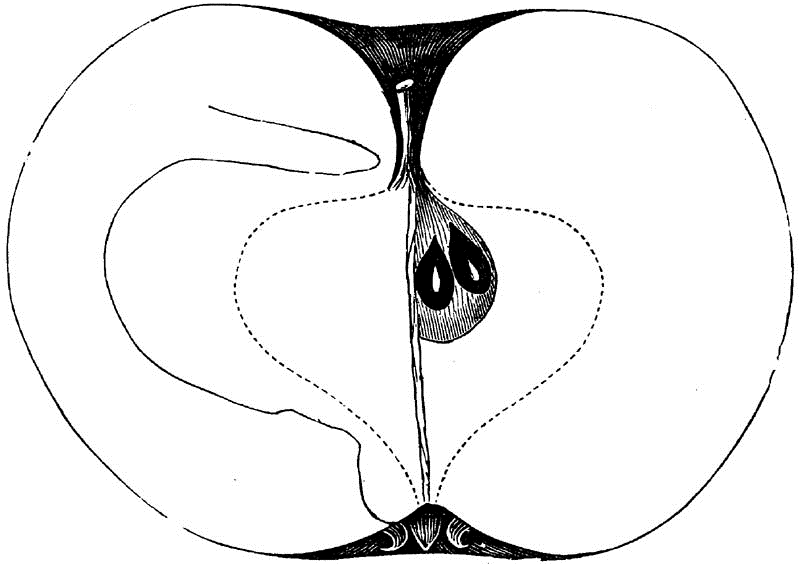
Fig. 51.—CAMACK SWEET.
This newly introduced sort is said to have originated in North Carolina or Georgia. The trees cultivated in the Northern States are yet too young for us to judge of their characteristics, but they appear to be healthy and vigorous.
Fruit medium to large, flat, regular.
Surface smooth, greenish-white, rarely blushed with red.
Basin broad, shallow, and regular or wavy; Eye medium, open.
Cavity deep, acute; Stem rather long; Flesh yellowish, firm, rather tough, but juicy, rich and sweet.
This variety keeps well, lasting until May. Not yet sufficiently tested in the North.
CampfieldNEWARK SWEETING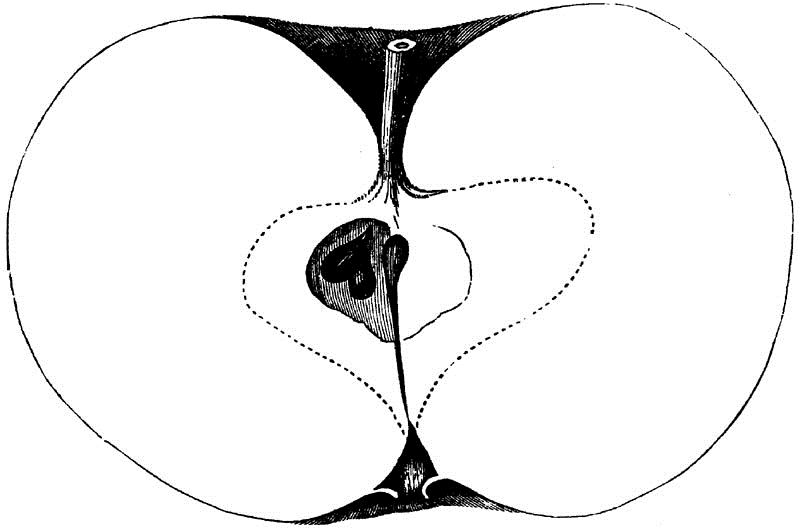
Fig. 52.—CAMPFIELD.
Tree vigorous, spreading, productive. This fruit is especially valuable for cider, but it may be used also in the kitchen; being a long keeper and often beautifully colored at maturity in the spring, it is often exposed on the fruit-stands, where it attracts purchasers by the great beauty of its brilliant colors.
Fruit always fair, but its figure is variable, being sometimes globular or conical. The characteristic form is round-oblate, regular; Size medium.
Surface very smooth, of a dull green, often suffused with a faint blush on the exposed side; but at maturity, bright lemon yellow, shaded with carmine; Dots minute, gray and indented.
Basin shallow, regular; Eye rather large, closed; Segments of medium length.
Cavity regular, with medium width and depth; Stem medium, rather stout.
Core wide, regular, closed, meeting the eye; Seeds numerous, plump; Flesh white, firm, tough; Juice very sweet and rich at maturity, making excellent cider.
Season, December until March.
Dillingham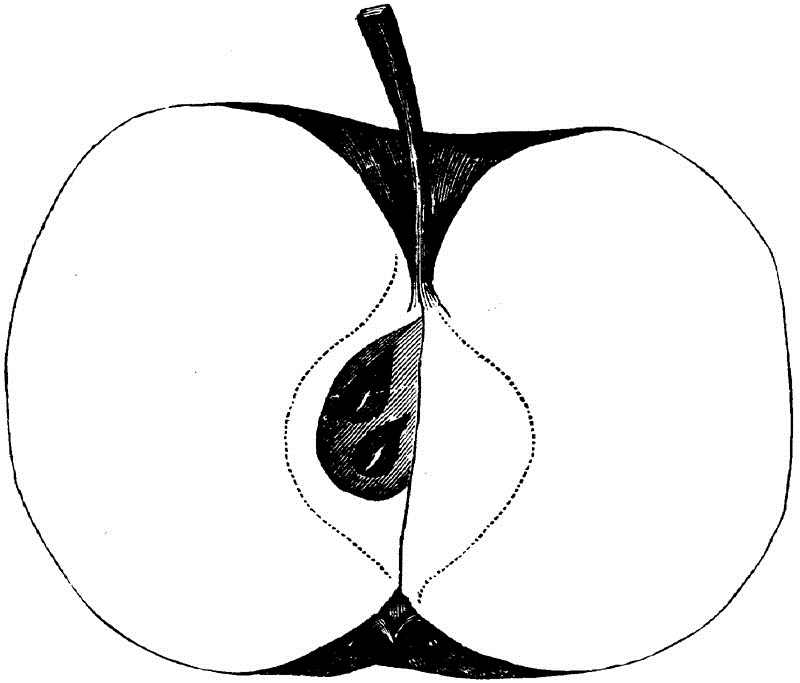
Fig. 53.—DILLINGHAM.
This variety was found in an old orchard of D.C. Richmond, near Sandusky, Ohio. Tree productive, and sufficiently vigorous.
Fruit round-oblate rather than flat, generally regular and of medium size; Surface rough, yellowish-green, and bronzed, or shaded with a purplish tint; Dots numerous russet.
Basin wide, folded; Eye small, closed.
Cavity rather deep, wide, regular, wavy, brown; Stem sometimes long, of medium size, red.
Core small and closed, meeting the eye; Seeds numerous, large, brown.
Flesh yellow; Flavor sweet, juicy; Use, good for baking; Season, November to February. Not highly esteemed nor largely cultivated, though its productiveness and sweetness would render it desirable for stock-feeding.
Ene's Winter SweetFrom J.S. Downer, Elkton, Kentucky; a southern fruit of some merit.
Fruit medium, flat, regular; Surface roughish, uneven, greenish-yellow, blushed and russeted; Dots numerous, minute, russet veined.
Basin abrupt, regular, leather-cracked; Eye large, open.
Cavity wide, wavy, brown; Stem medium.
Core round, closed, clasping; Seeds numerous, angular, imperfect; Flesh yellow, fine grained; Flavor very sweet, rich; Quality quite good; Use, table; Season, December.
Green SweetHONEY GREENING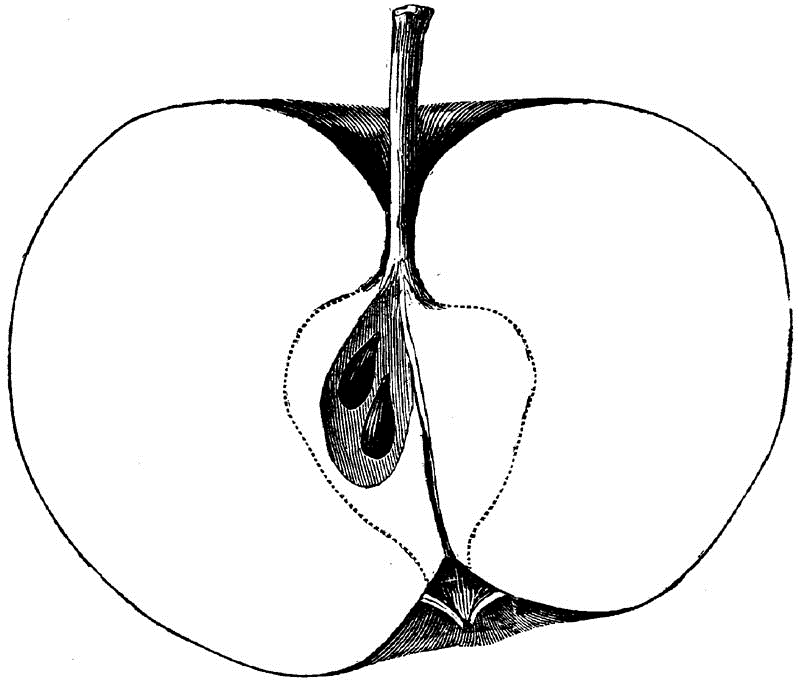
Fig. 54.—GREEN SWEET.



